MODIS-Based Monthly LST Products over Amazonia under Different Cloud Mask Schemes
Abstract
:1. Summary
2. Data Description
2.1. Data Records: LST Products
- var1: temperature product (“lstd” for daytime LST).
- var2: magnitude of interest (“temp” for absolute temperature in K; “absan” for temperature anomalies (K or °C); “stdan” for standardized anomalies (K or °C); “ncsd” for number of clear-sky days).
- product: MODIS reference product (mod11c1v5, mod11a1v5, myd11c1v5, myd11a1v5, etc.).
- product: MODIS reference product (mod11c1v5, mod11a1v5, myd11c1v5, myd11a1v5, etc.).
- cloudmask: cloud mask product used to filter out cloudy pixels (mod35, maiac, fmask).
- year and month: date of the monthly LST product.
2.2. Data Repository
3. Methods
3.1. MODIS LST Products
3.2. Cloud Masks
3.2.1. MOD35
3.2.2. FMASK
3.2.3. MAIAC
3.3. MODIS Land Cover
3.4. Producing the Monthly LST Products
3.5. Sample Results
4. User Notes
Acknowledgments
Author Contributions
Conflicts of Interest
References
- Malhi, Y.; Wood, D.; Baker, T.R.; Wright, J.; Phillips, O.L.; Cochrane, T.; Meir, P.; Chave, J.; Almeida, S.; Arroyo, L.; et al. The regional variation of aboveground biomass in old-growth Amazonian forests. Glob. Chang. Biol. 2006, 12, 1107–1138. [Google Scholar] [CrossRef]
- Gedney, N.; Valdes, P.J. The effect of Amazonian deforestation on the northern hemisphere circulation and climate. Geophys. Res. Lett. 2000, 27, 3053–3056. [Google Scholar] [CrossRef]
- Groombridge, B.; Jenkins, M.D. World Atlas of Biodiversity; University of California Press: Berkeley, CA, USA, 2003. [Google Scholar]
- Clark, D.A.; Keeling, C.D.; Clark, D.B. Tropical rain forest tree growth and atmospheric carbon dynamics linked to inter-annual temperature variation during 1984–2000. Proc. Natl. Acad. Sci. USA 2003, 100, 5852–5857. [Google Scholar] [CrossRef] [PubMed]
- Doughty, C.E.; Goulden, M.L. Are tropical forests near a high temperature threshold? J. Geophys. Res. 2008, 113, G00B07. [Google Scholar] [CrossRef]
- Galbraith, D.; Levy, P.E.; Sitch, S.; Huntingford, C.; Cox, P.; Williams, M.; Meir, P. Multiple mechanisms of Amazonian forest biomass losses in three dynamic global vegetation models under climate change. New Phytol. 2010, 187, 647–665. [Google Scholar] [CrossRef] [PubMed]
- Soares-Filho, B.S.; Nepstad, D.C.; Curran, L.M.; Cerqueira, G.C.; Garcia, R.A.; Ramos, C.A.; Voll, E.; McDonald, A.; Lefebvre, P.; Schlesinger, P. Modelling conservation in the Amazon basin. Nature 2006, 440, 520–523. [Google Scholar] [CrossRef] [PubMed]
- Chambers, J.Q.; Asner, G.P.; Morton, D.C.; Anderson, L.O.; Saatchi, S.S.; Espírito-Santo, F.D.; Palace, M.; Souza, C., Jr. Regional ecosystem structure and function: Ecological insights from remote sensing of tropical forests. Trends Ecol. Evol. 2007, 22, 414–423. [Google Scholar] [CrossRef] [PubMed]
- Jiménez-Muñoz, J.C.; Mattar, C.; Sobrino, J.A.; Malhi, Y. Digital thermal monitoring of the Amazon forest: An intercomparison of satellite and reanalysis products. Int. J. Digit. Earth 2016, 9, 477–498. [Google Scholar] [CrossRef]
- Wan, Z. New refinements and validation of the MODIS land surface temperature/emissivity products. Remote Sens. Environ. 2008, 112, 59–74. [Google Scholar] [CrossRef]
- Wan, Z. Collection-5 MODIS Land Surface Temperature Products Users’ Guide; ICESS, University of California: Santa Barbara, CA, USA, 2007. [Google Scholar]
- Jiménez-Muñoz, J.C.; Mattar, C.; Sobrino, J.A.; Malhi, Y. A database for the monitoring of thermal anomalies over the Amazon forest and adjacent intertropical oceans. Sci. Data 2015, 2. [Google Scholar] [CrossRef] [PubMed]
- Lyapustin, A.; Wang, Y.; Frey, R. An automatic cloud mask algorithm based on time series of MODIS measurements. J. Geophys. Res. 2008, 113. [Google Scholar] [CrossRef]
- Hilker, T.; Lyapustin, A.I.; Tucker, C.J.; Sellers, P.J.; Hall, F.G.; Wang, Y. Remote sensing of tropical ecosystems: Atmospheric correction and cloud masking matter. Remote Sens. Environ. 2012, 127, 370–384. [Google Scholar] [CrossRef]
- Zhu, Z.; Woodcock, C.E. Object-based cloud and cloud shadow detection in Landsat imagery. Remote Sens. Environ. 2012, 118, 83–94. [Google Scholar] [CrossRef]
- Wan, Z. MODIS Land-Surface Temperature Algorithm Theoretical Basis Document (LST ATBD); Institute for Computational Earth System Science, University of California: Santa Barbara, CA, USA, 1999. [Google Scholar]
- Ackerman, S.A.; Strabala, K.I.; Menzel, W.P.; Frey, R.; Moeller, C.; Gumley, L.; Baum, B.; Seeman, S.W.; Zhang, H. Discriminating Clear-Sky from Cloud with MODIS-Algorithm Theoretical Basis Document (MOD35) (ATBD Reference Number: ATBD-MOD-06); Goddard Space Flight Center: Greenbelt, MD, USA, 2002. [Google Scholar]
- Zhu, Z.; Wang, S.; Woodcock, C.E. Improvements and expansion of the Fmask algorithm: Cloud, cloud shadow and shadow detection for Landsats, 4–7, 8 and Sentinel 2 images. Remote Sens. Environ. 2015, 159, 269–277. [Google Scholar] [CrossRef]
- Wilson, M.J.; Oreopoulos, L. Enhancing a simple MODIS CLOUD mask algorithm for the Landsat data continuity mission. IEEE Trans. Geosci. Remote 2013, 51, 723–731. [Google Scholar] [CrossRef]
- Giglio, L. MODIS Collection 5 Active Fire Products Users’ Guide Version 2.5; University of Maryland: College Park, MD, USA, 2013. [Google Scholar]
- MAIAC dataset. Available online: ftp://dataportal.nccs.nasa.gov/DataRelease/SouthAmerica (accessed on 24 May 2016).
- Lyapustin, A.; Wang, Y. MAIAC: Multi-Angle Implementation of Atmospheric Correction for MODIS (Algorithm Theoretical Basis Document v.1.0); Goddard Earth Science and Technology Center UMBC: Baltimore, MD, USA; NASA GSFC: Greenbelt, MD, USA, 2008. [Google Scholar]
- Strahler, A.; Muchoney, D.; Borak, J.; Friedl, M.; Gopal, S.; Lambin, E.; Moody, A. MODIS Land Cover and Land-Cover Change (MODIS Land Cover Product Algorithm Theoretical Basis Document (ATBD) Version 5.0); Boston University: Boston, MA, USA, 1999. [Google Scholar]
- Toomey, M.; Roberts, D.A.; Still, C.; Goulden, M.L.; McFadden, J.P. Remotely sensed heat anomalies linked with Amazonian forest biomass declines. Geophys. Res. Lett. 2011, 38. [Google Scholar] [CrossRef]
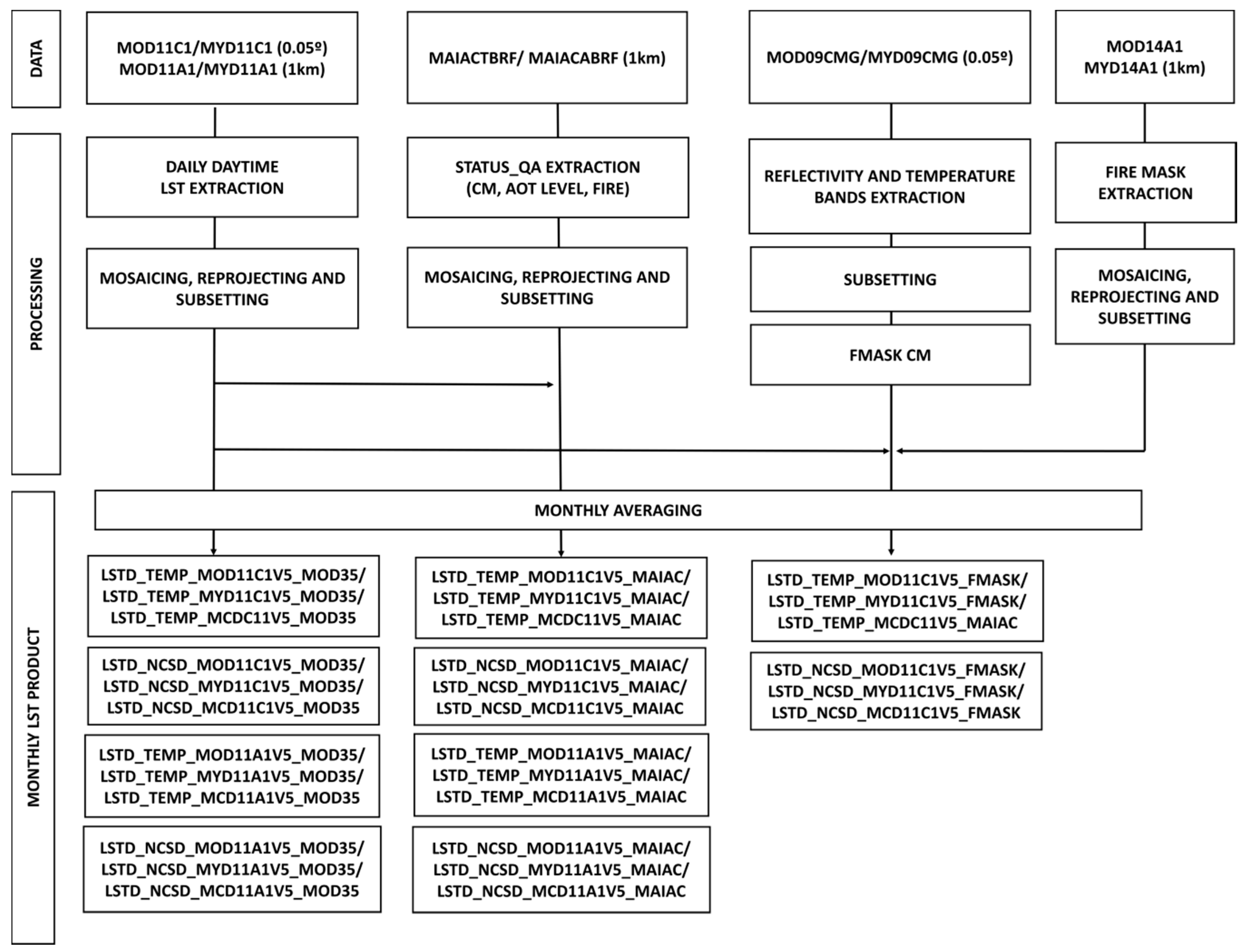
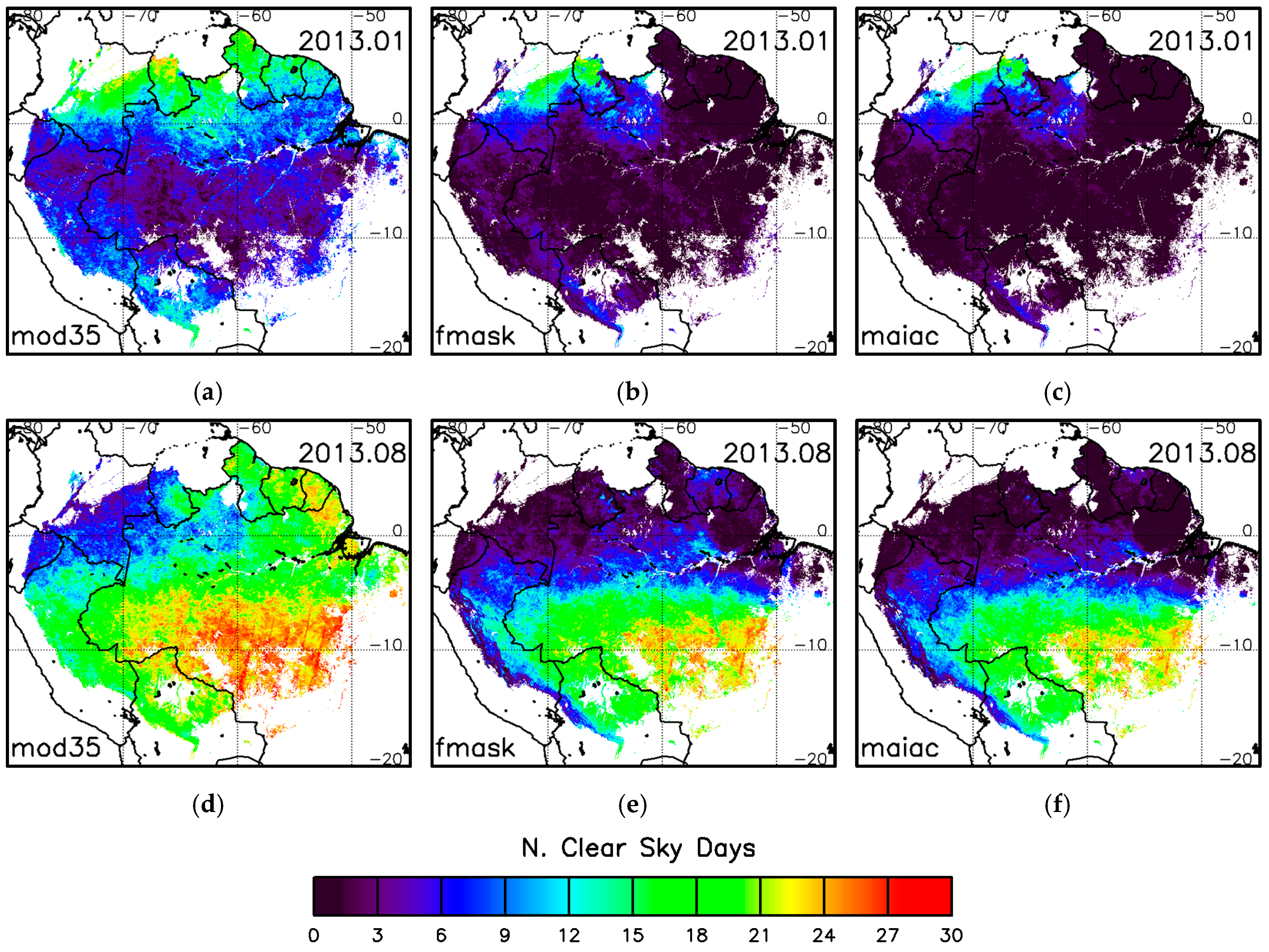
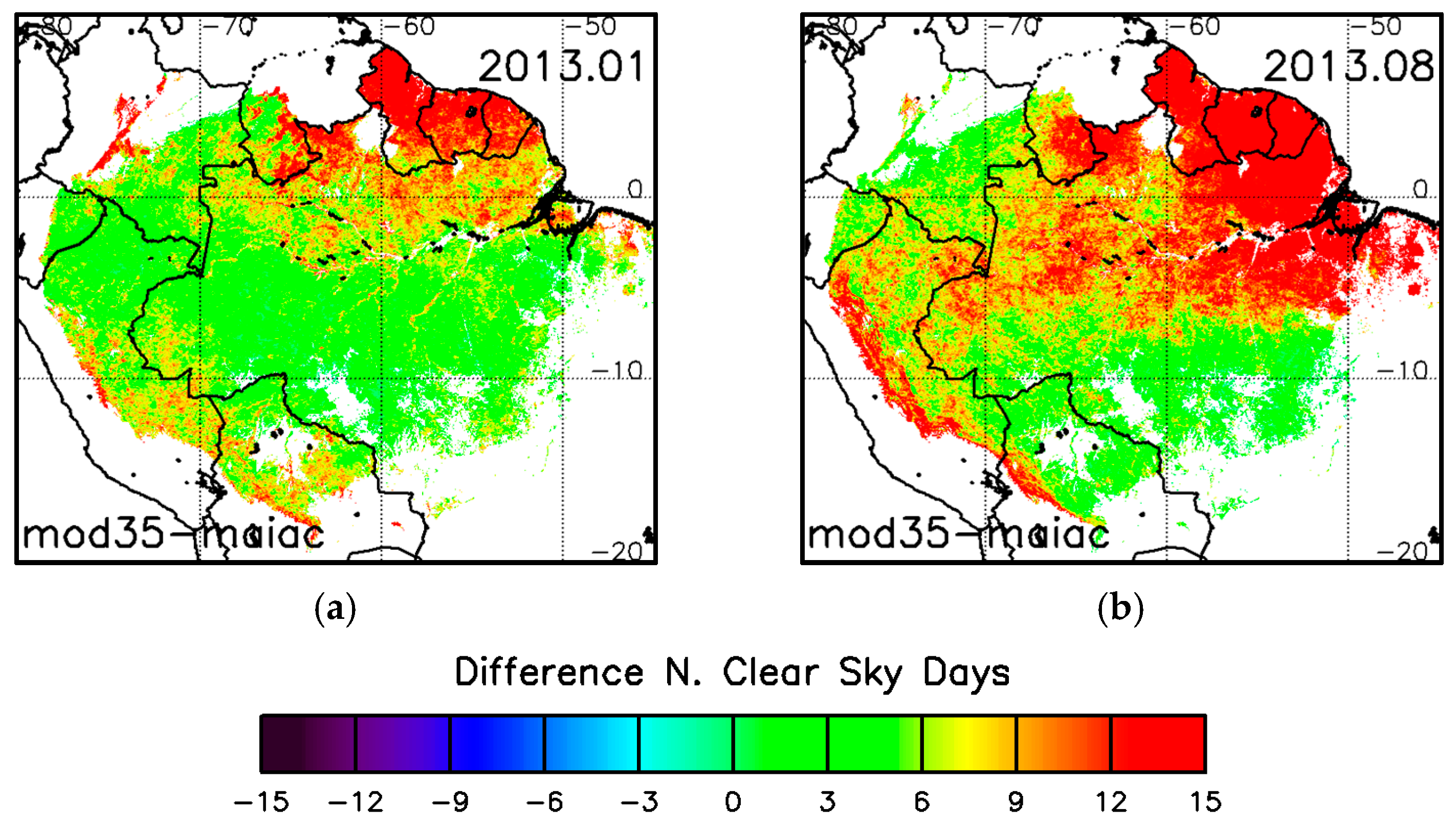
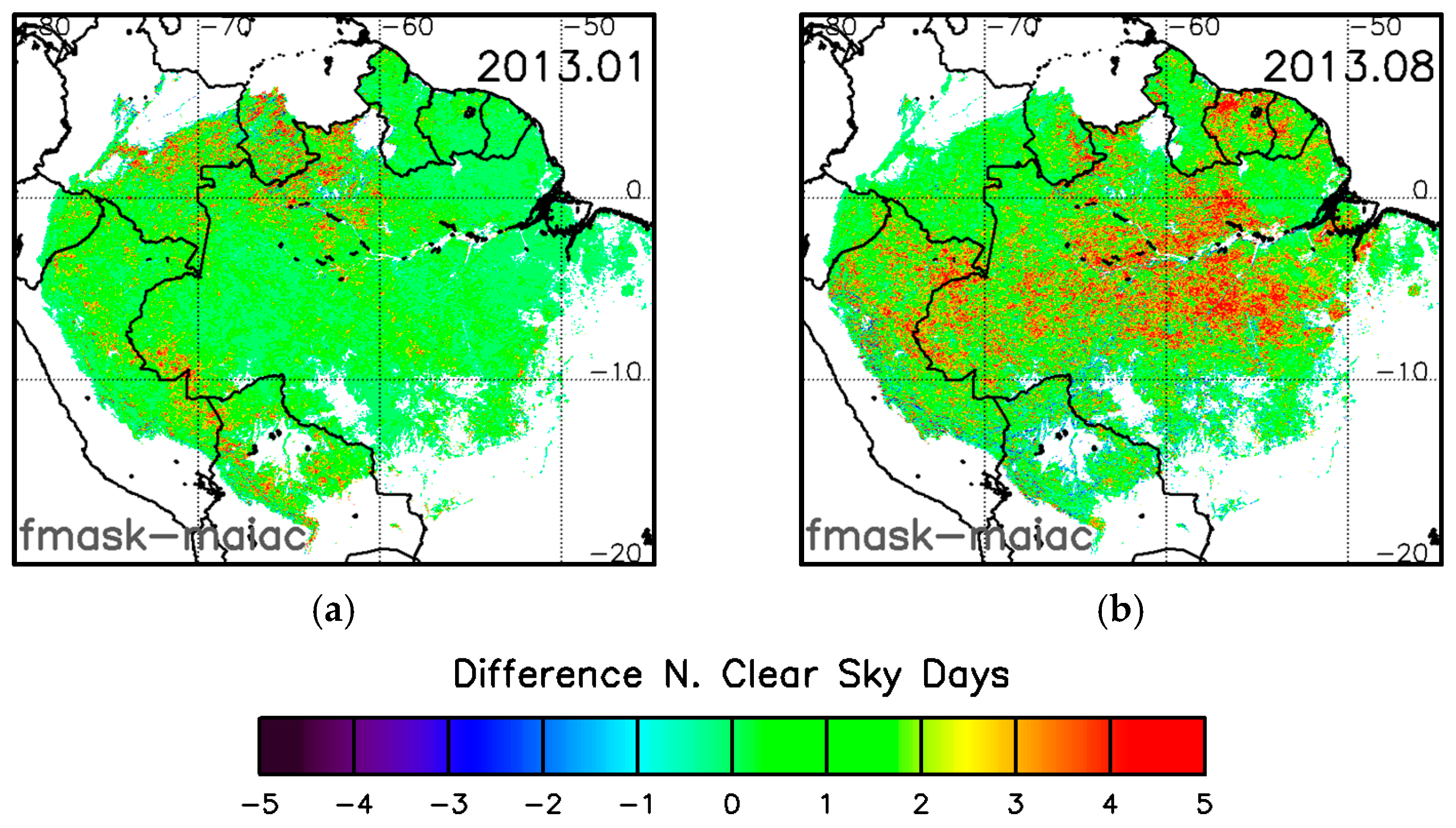

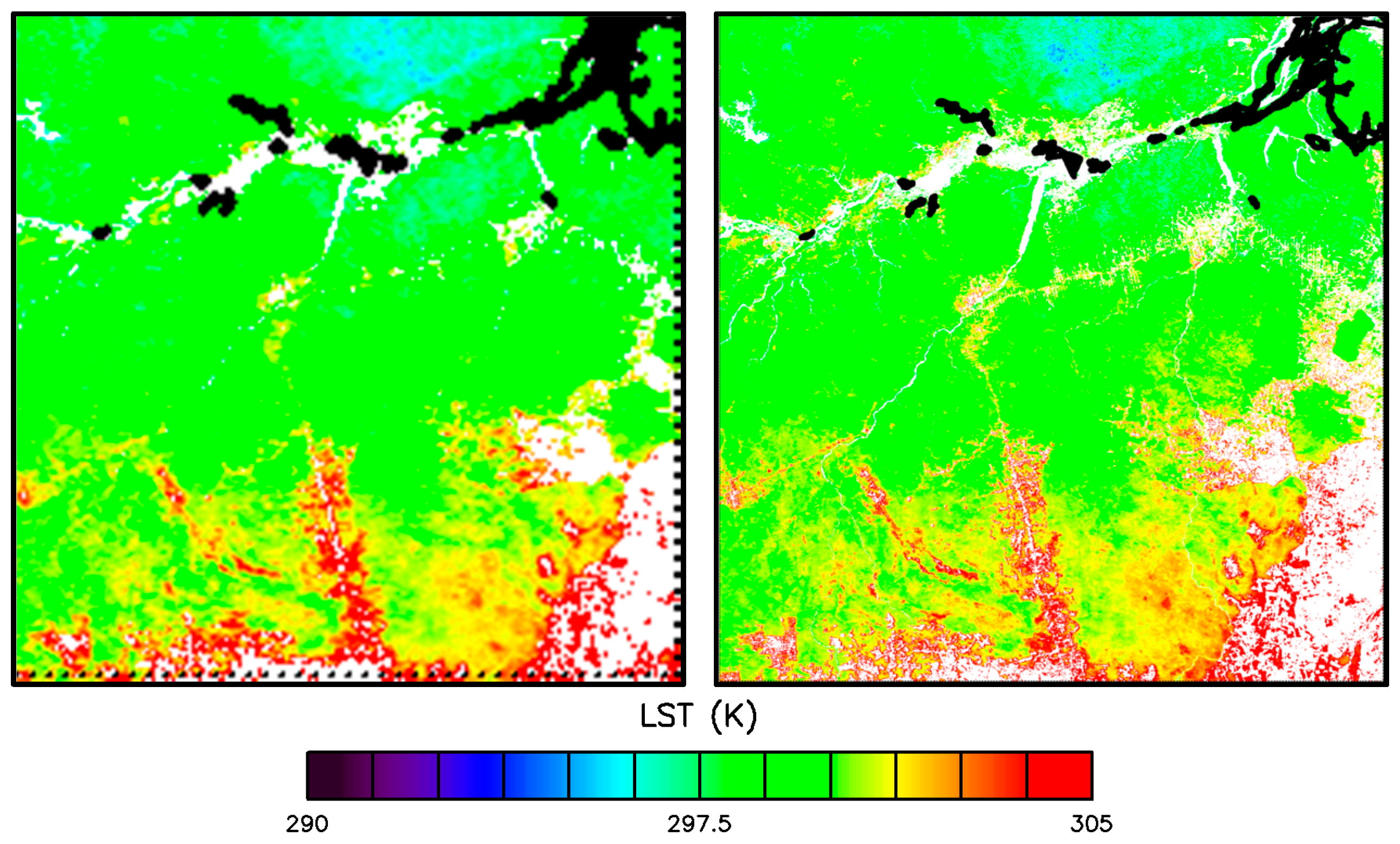
| Layer | Availability | Resolution | Parameter |
|---|---|---|---|
| lstd_temp_mod11c1v5_mod35 | 2000–present | 0.05° | Monthly Daytime LST (K) |
| lstd_temp_mod11a1v5_mod35 | 2000–present | 0.009° | Monthly Daytime LST (K) |
| lstd_temp_mod11c1v5_maiac | 2000–2014 * | 0.05° | Monthly Daytime LST (K) |
| lstd_temp_mod11a1v5_maiac | 2000–2014 * | 0.009° | Monthly Daytime LST (K) |
| lstd_temp_mod11c1v5_fmask | 2000–present | 0.05° | Monthly Daytime LST (K) |
| lstd_temp_myd11c3v5_mod35 | 2002–present | 0.05° | Monthly Daytime LST (K) |
| lstd_temp_myd11a1v5_mod35 | 2002–present | 0.05° | Monthly Daytime LST (K) |
| lstd_temp_myd11c1v5_maiac | 2002–present | 0.009° | Monthly Daytime LST (K) |
| lstd_temp_myd11a1v5_maiac | 2002–2014 * | 0.05° | Monthly Daytime LST (K) |
| lstd_temp_myd11c1v5_fmask | 2002–2014 * | 0.009° | Monthly Daytime LST (K) |
| lstd_temp_mcd11a1v5_mod35 | 2002–present | 0.05° | Monthly Daytime LST (K) |
| lstd_temp_mcd11a1v5_mod35 | 2002–present | 0.009° | Monthly Daytime LST (K) |
| lstd_temp_mcd11c1v5_maiac | 2002–2014 * | 0.05° | Monthly Daytime LST (K) |
| lstd_temp_mcd11a1v5_maiac | 2002–2014 * | 0.009° | Monthly Daytime LST (K) |
| lstd_temp_mcd11c1v5_fmask | 2002–present | 0.05° | Monthly Daytime LST (K) |
| amazonia_mask_mcd12q1 | 2012 | 0.009° | Forests delimitation |
| amazonia_mask_mcdc12c1 | 2012 | 0.05° | Forests delimitation |
| Module | Link | Description |
|---|---|---|
| Web site | http://ipl.uv.es/thamazon/web | Presentation, news, updates, references, ancillary information |
| Viewer | http://ipl.uv.es/thamazon | Visualization of thermal anomalies using a Google Earth© Interface |
| FTP site | ftp://[email protected] | Data repository; Products available for download (free access) |
© 2016 by the authors; licensee MDPI, Basel, Switzerland. This article is an open access article distributed under the terms and conditions of the Creative Commons Attribution (CC-BY) license (http://creativecommons.org/licenses/by/4.0/).
Share and Cite
Gomis-Cebolla, J.; Jiménez-Muñoz, J.C.; Sobrino, J.A. MODIS-Based Monthly LST Products over Amazonia under Different Cloud Mask Schemes. Data 2016, 1, 2. https://doi.org/10.3390/data1020002
Gomis-Cebolla J, Jiménez-Muñoz JC, Sobrino JA. MODIS-Based Monthly LST Products over Amazonia under Different Cloud Mask Schemes. Data. 2016; 1(2):2. https://doi.org/10.3390/data1020002
Chicago/Turabian StyleGomis-Cebolla, José, Juan C. Jiménez-Muñoz, and José A. Sobrino. 2016. "MODIS-Based Monthly LST Products over Amazonia under Different Cloud Mask Schemes" Data 1, no. 2: 2. https://doi.org/10.3390/data1020002








